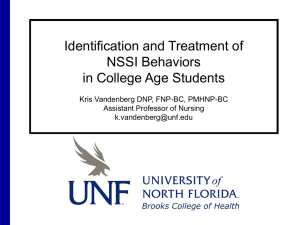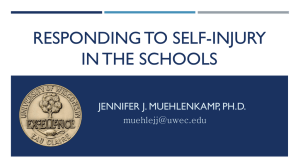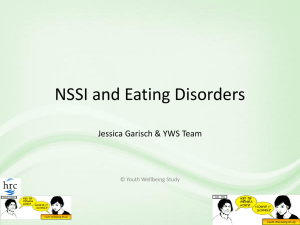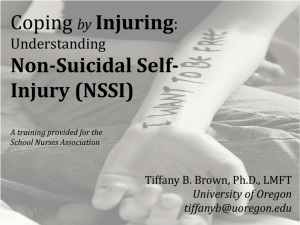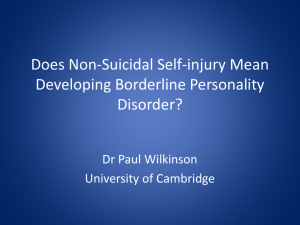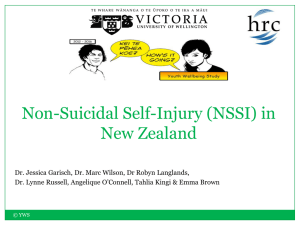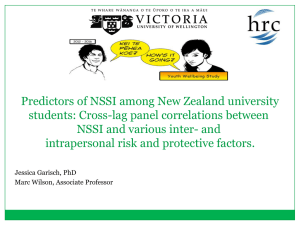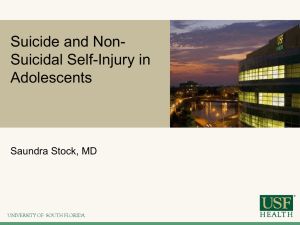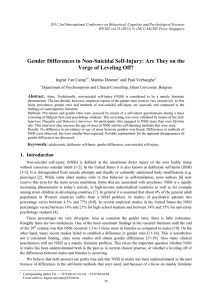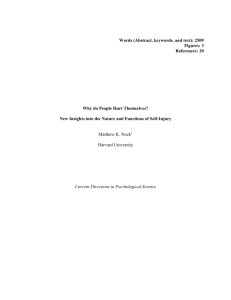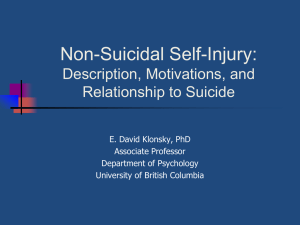NSSI - District School Board Ontario North East
advertisement
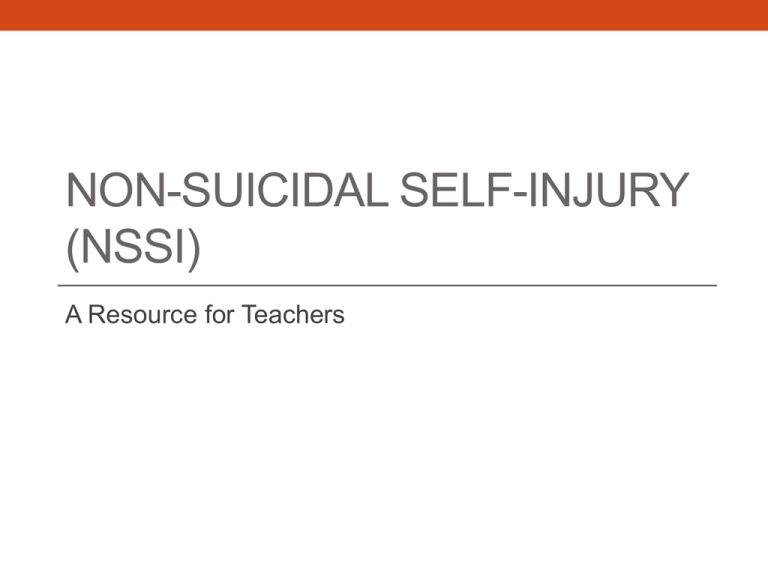
NON-SUICIDAL SELF-INJURY (NSSI) A Resource for Teachers Defining non-suicidal self-injury (NSSI) • Deliberate self-inflicted injury to one’s own body tissues without conscious intent to die • Not considered a socially approved practice within one’s culture • Excludes ear piercing, tattooing, circumcision, or cultural healing rituals Prevalence rates • 15% to 20% of middle and high school students engage in • • • • NSSIB Prevalence rates are much higher in clinical samples of adolescents (between 12-65%) Typical age of onset occurs during middle school, roughly between the ages of 12 to 15 years In adolescent samples, females are more likely to report having self-injured but by late adolescence, young males and females report similar rates The most commonly found risk factors for NSSI is having difficulties with regulating emotions Common forms of NSSI • scraping or scratching • interfering with a skin • cutting skin • self-hitting or banging (to break or bruise) • burning • pinching healing wound • self-biting • picking or ripping skin NSSI vs. Suicidal Behaviour Non-suicidal self-injury Suicidal behaviour Intent To get immediate relief from negative emotions To die in order to permanently escape emotional pain Repetition More frequent Less frequent Lethality Often involves less lethal methods but with a potential for lethality Tends to involve more lethal methods Psychological Often used to relieve consequences psychological pain Often aggravates psychological pain Gender Occurs more often in women but men are more likely to die by suicide May or may not occur often in women, depending on sample Why do people engage in NSSI? • To reduce negative emotions and thoughts • NSSI involves the body’s natural pain killers. This can result in the release of pleasant feelings • To stop themselves from acting on suicidal thoughts and urges • To punish one-self • To reconnect with one-self and others NSSI is complex and is often the result of many converging factors. The explanations are equally complex. How can School Personnel help at the time of disclosure? Do: • Respond in a calm and caring manner. • Don't be afraid to state, "I've noticed injuries that appear to be • • • • • • self-inflicted, I care about why you might be doing that" or, "it appears you have hurt yourself, do you want to talk about it?” Understand that this is the student’s way of coping with pain. Have a non-judgemental compassion for the student’s experience. Offer to be a caring adult for the student while they are seeking mental health support. Acknowledge their feelings; offer to listen, be available. Encourage participation in extracurricular activities and outreach in the community (e.g. volunteering with animals, nursing homes, tutoring or mentoring). Discover the student’s strengths. How can School Personnel help at the time of disclosure? Don’t • Be overly reactive as this could alienate the student and damage the • • • • • • • • • developing alliance. Show excessive interest in the NSSI behavior. Permit the student to relive the experiences of NSSI in detail, as this can be triggering. Try to stop the behaviour with threats or ultimatums. Discourage self‐injury; threaten hospitalization, use punishment or negative consequences. Act shocked, overreact, say or do anything to cause guilt or shame. Publicly humiliate the student . Talk about the student’s NSSI in front of class or peers. Agree to hold NSSI behaviour confidential. Make deals or promises you can’t keep in an effort to stop NSSI. School response protocol Wounds are severe or lifethreatening or the student is attempting suicide Wounds are not lifethreatening • Provide first aid and assess • Report all concerns related NSSI lethality of injury • Send someone to call 911 and to communicate with the principal or designate. • Listen empathically and carefully to the student’s message. • The principal or designate will call the parent(s) or guardian(s). to the school principal or designate. • A suicide risk review will be conducted by an ASIST trained staff • The ASIST trained staff and principal or designate, will identify the level of NSSI risk Should the student be identified as potentially suicidal, DSB Ontario North East Youth Suicide Prevention, Intervention and Response Protocols are followed. Staff suspects NSSI Student shows signs and symptoms of NSSI School staff becomes aware of student NSSI Self-disclosure of NSSI Contact the Principal or Designate DSB Ontario North East Protocol Flowchart ASIST trained staff conducts suicide review and consults with the principal or designate NSSI - Low Risk NSSI - Moderate of High Risk * Any associated risk of suicide * Self-injury is superficial * Severity of self-injury is high * No co-occurring mental health * Co-occuring mental health issues or related conditions health problems. * Encourage student to call parent(s)/guardian(s) * If child is under the age of 12, call parent(s)/guardian(s) * Refer student to Mental Health Team and/or external services * Follow up 2 weeks later If the student is suicidal, follow suicide protocols Provide first aid and assess lethality * Not suicidal issues or only mild mental Peer disclosure of NSSI * Call parent(s)/guardian(s) * Encourage parent(s)/guardian(s) to call their family physician, NEOFACS Intake for Mobile Crisis Response 1-866-229-5437 or another emergency mental health facility * Follow up 2 weeks later (see: http://docushare.dsb 1.edu.on.ca/docush are/dsweb/Get/Doc ument78908/DSB1%20IN TERVENING%20WI TH%20SIB%20%20Protocols%20%20Draft(1).pdf). Confidentiality Be cautious about telling the student that you won’t tell anyone about their self-injury. There could be • a risk of suicide • a health risk • a self-injuring group of peers, and/or As per our protocol, staff shall report all concerns related to potential self-harm to the school principal, vice-principal or designate: http://docushare.dsb1.edu.on.ca/docushare/dsweb/Get/Document78908/DSB1%20INTERVENING%20WITH%20SIB%20%20Protocols%20-%20Draft(1).pdf. Circles of vulnerability for contagion of NSSI Geographical proximity Social proximity Psychological proximity Contagion in Schools Schools • Trends have been suggested whereby multiple students who self-injure, communicate frequently about NSSI, and trigger the behaviour in each other. • Youth may self-injure in front of each other, share the same tools, implement or take turns injuring the body parts of others in the group. • Some adolescents will pick up self-injuring behaviour from siblings or peer group leaders. Managing contagion in the school When discussing NSSI with students, the following guidelines will help in preventing contagion: 1. Do not allow students to share detailed information regarding NSSI, reveal their scars, or share NSSI related images or stories. 2. Do not use school-wide assemblies, newsletters, school newspapers to address an “outbreak” of NSSI. 3. Do not present media that glamorize NSSI [as part of classroom curriculum]. 4. When educating youth about NSSI, discuss the behavior in its broader context; that is, as a maladaptive coping strategy among several others (such as substance abuse, or risktaking). 5. Emphasize the need for students who are engaging in the behavior to seek support. THANK YOU! • We hope that you found this a useful introduction to NSSI. • For more information, please refer to pp. 121 – 125 of Supporting Minds: An Educator’s Guide to Promoting Students’ Mental Health and Well-being: http://www.edu.gov.on.ca/eng/document/reports/Suppo rtingMinds.pdf Should you have questions, your Mental Health Leader is available to provide ongoing support and leadership to your team.
